Landscaping not only looks good, it increases the value of a home, helps to deter crime, makes people feel welcome and attracts customers. But did you know that landscaping also provides a host of environmental benefits?
Properly placed plants can reduce energy costs by shading homes in summer and deflecting winter winds. Grass and trees remove carbon dioxide, produce life-giving oxygen, and help to capture dust and smoke particles. Contact Landscaping Harrisburg PA now!

Soil is a complex mixture of mineral particles, organic material, air and water. It is a living ecosystem that provides vital functions to support plant growth and the soil food web, as well as regulate water flow and buffer pollutants. It also provides physical stability and sorting, and cycles nutrients to plants.
Soils are formed from the weathering and degradation of rocks and minerals by physical and chemical processes, and the action of living organisms. They form in layers (horizons) that differ from the original rock and mineral material in color, texture, structure, consistency, density, nutrient content and other characteristics.
The lower boundary of soil is the limit between soil and hard rock or other earthy materials that do not support rooted vegetation. The upper boundary is the point where the water table is close to or above ground level.
A soil’s texture is determined by the relative percentage of sand, silt and clay particles. A soil with a high percentage of sand and silt has a sandy texture. Clay-rich soils are firm and dense. A soil with a balance of the three types of particles is known as loam.
Soils are a complex system that is unique to each place on the planet. They provide habitat and resources for a great diversity of plants, animals and microorganisms. They perform vital functions to sustain and enhance life, regulate water and air flow, filter and buffer pollutants, cycle nutrients, provide physical stability, and sort and stabilize particles.
The soil has an intrinsic value that is usually underestimated and underappreciated. Economically, the services provided by a single hectare of soil can be worth tens of thousands of dollars a year.
Soils are a living, dynamic system that need to be kept healthy and balanced. Soil tests help us understand how the soil is functioning and what its needs are. We test for a variety of nutrients including nitrogen, phosphorus, potassium, sulfur and micronutrients like iron, manganese, chlorine, zinc and molybdenum. The test results also show us what the physical characteristics of the soil are and how it will respond to certain practices, such as composting and crop rotation. We recommend testing your soil every three to five years, or more often if you are using fertilizers.
Water
The use of water in landscaping creates a beautiful outdoor space and enhances the function of the landscape. However, many homeowners are concerned about the amount of water used in their landscaping. With careful planning, implementation and maintenance, it is possible to have a lush green yard without using a large amount of water.
Landscapes provide a variety of important benefits such as beauty, amelioration of the effects of heat and pollution; noise reduction, soil erosion control, dust control, wildlife habitat and carbon sequestration. They also conserve our watersheds by absorbing rainwater, filtering runoff and reducing energy use through shading. However, landscapes are often characterized as “water thirsty” and the current state of California’s water supply has caused a shift in perceptions about their role.
The art of landscape is an expression of the human desire for harmony with nature and with our own environment. Artists, both modern and traditional, have used the visual language of landscape to portray a range of ideas, emotions and moods. Many of these artworks have a strong sense of place, evoke memories of past experiences or create imagined places where people might live, work and play.
Artworks that incorporate elements of the natural environment such as landforms, vegetation, water and sky are called landscape art. Many of these works are created in the style of realism, though impressionism and abstract expressionism can also be used to convey landscapes in art.
In addition to providing a pleasant aesthetic, landscaping can improve a property’s value, increase its utility and make it more comfortable for residents. In addition, landscaping can help to reduce the need for potable water by reducing or eliminating the need for irrigation.
Homeowners can minimize water usage in their landscape by planting native and adapted plants, installing drip or low-volume irrigation systems and mulching the garden area. In addition, regular maintenance such as checking for leaks and trimming weeds can help to conserve water. In addition, using compost and mulch will keep soil moist longer and prevent evaporation. It is also important to water properly – over-watering and inefficient watering practices are common causes of water waste in landscapes.
Plants
Plants can add color, texture and interest to the landscape. They can also be used to create a specific aesthetic design or function. The plants chosen for a particular space should be based on their cultural requirements, the surrounding environment and the needs of the homeowner.
The types of plants used in a landscape design can include ground covers, shrubs, perennials, trees and ornamental grasses. Ground cover plants hug the soil and act as a living mulch. They help to hold moisture in the soil during summer, keep it warm during winter and suppress weeds. These plants are especially useful in steep hillsides, where mowing is not an option and erosion control is required.
Shrubs can be evergreen or deciduous (lose their leaves seasonally). They are used to provide color, contrast and interest in the landscape. They are also often used to define spaces and create boundaries. They are often used in combination with ground covers and perennials to provide depth. Shrubs can also be trained into shapes such as topiaries and are a good choice for those that want to add a sense of formality to the landscape.
Perennials are flowers that come back year after year. They add color, texture and interest to the landscape and can be used for a variety of purposes, including cutting gardens, pollinator gardens and edible landscaping. Perennials are usually low maintenance and can be planted in early spring or fall.
Ornamental grasses are clump-forming plants with flower spikes, seeds or bracts. They can be evergreen or deciduous and are a great addition to the landscape as they are low maintenance, durable and drought tolerant.
Trees can be deciduous or evergreen and are an important part of the landscape as they provide structure, privacy and height. They are also useful in filtering water, cooling the area and providing shade.
Native plant species are a natural way to reduce irrigation and chemical use in the landscape, and they can enhance the beauty of the home and increase property value. They also improve the quality of air by reducing the amount of dust and pollutants in the atmosphere, acting as natural air purifiers.
Maintenance
A well-groomed landscape can significantly increase your home’s resale value. It also helps retain soil texture and quality, reduces erosion during heavy rainfall, and promotes healthy plant growth. Moreover, it can improve your health and well-being by providing an opportunity to relax and enjoy nature.
In addition to lawn care, landscaping can include flower beds, water elements, retaining walls, and even hardscaping, which includes the installation of concrete, clay, or stone pathways in residential and commercial properties. This type of landscape can be designed to meet the specific needs of a client, whether it is to provide shade, increase curb appeal, or create functional spaces.
If you are looking for a professional lawn and landscaping maintenance company, it is important to choose one that has excellent customer reviews and is dedicated to delivering the highest quality work possible. You may also want to look for a company that offers both lawn and landscaping services so that they can keep your property in top shape all year round.
Some landscapers specialize in planting and transplanting shrubs, flowers, and trees. These individuals are responsible for preparing and mulching soil, determining optimal placement, adjusting irrigation schedules, and controlling pests to ensure plant growth and a healthy landscape.
Other landscapers focus on lawn care, which can include mowing, edging, aerating, overseeding, and dethatching turfgrass areas to maintain their health, appearance, and vigor. They may also apply herbicides or fertilizers to control weeds and insects.
Landscaping is a complex and time-consuming task, but it can be very rewarding when done correctly. Whether you are considering making your yard into your own personal paradise or simply want to add some curb appeal to your home, landscaping is an important investment. However, it is essential to avoid common mistakes when hiring a professional landscaping company to complete your project. These mistakes can be costly and prevent you from getting the results that you want. The most common landscaping mistakes include:

